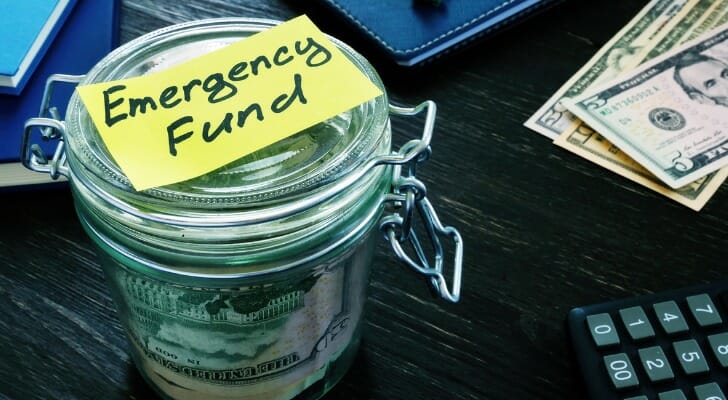Saving is a good money habit to develop, especially if you don’t want to be blindsided by an unexpected expense. But you might be wondering, how much you should have in savings. When discussing emergency savings, a general rule of thumb is to keep three to six months’ worth of expenses on hand. Aside from deciding how much to save, it’s also important to find the right place to keep it. A financial advisor can help you with both of these questions and find the right balance for your unique situation.
How Much Does the Average Person Have in Savings?
Determining how much the average person has in savings is difficult, as there’s no single universal measure for that statistic. According to the Federal Reserve’s most recent Survey of Consumer Finances, the median savings balance in the U.S. was $5,300. The average savings, meanwhile, was $41,600. Those figures refer to balances in deposit accounts, including savings and CD accounts.
The Fed collected those numbers prior to the start of the COVID-19 pandemic, which had far-reaching financial impacts for millions of households in the U.S. It may be difficult to gauge the full impacts of the pandemic on emergency savings until data from the latest Survey of Consumer Finances is released in 2023.
There is some good news, however, as Fed data shows that the percentage of households that would be able to pay for a $400 emergency in cash has increased from 63% to 68% since 2019. That suggests that Americans are still maintaining at least some emergency savings to help them deal with unanticipated expenses.
How Much Should I Have in Savings?
Financial experts often recommend keeping three to six months’ worth of expenses in an emergency fund. The reasoning is that amount of money should be sufficient to see you through most emergencies, including job losses, layoffs or illnesses.
Calculating how much you should have in savings using that rule of thumb is simple. Just multiply your monthly expenses by three and six. So, for example, if your expenses come to $5,000 a month then your emergency fund should be $15,000 to $30,000. When determining how much to keep in savings, it’s important to be clear about expenses to include. Priority expenses to pay include:
- Housing (i.e., rent or mortgage payments)
- Utilities, including electric and water
- Essential food
- Health care
Cell phone and internet service may be included as essential utilities if you need those things to file for unemployment, search for jobs or make extra money with an online side hustle while you’re trying to find steady work. When determining the amount of your emergency fund it’s a good idea to keep a budget.
Nonessential expenses include things like new clothes, dinner out, travel or entertainment. The more nonessential spending you can cut out, the longer your emergency fund might last. For instance, if you have $15,000 in an emergency fund but you’re able to cut your spending from $5,000 down to $3,000, then your savings could stretch for five months instead of just three.
Where to Keep Emergency Savings

Having money in savings can be a huge help when life throws a curve ball your way. Where you keep that money matters when it comes to how easily accessible it is and how much interest you can earn.
Generally, it’s a good idea to keep emergency savings or other short-term savings in a bank account. Specifically, that means a savings account that’s linked to a checking account. By keeping money separate in savings, you can earn interest on it and you’re less likely to spend it for non-emergencies. And should you have an unexpected expense to pay, you can easily transfer funds over to checking.
There are many different savings account options to choose from, including:
- Traditional savings accounts at brick-and-mortar banks or credit unions
- High-yield savings accounts at online banks
- Money market savings
- Certificate of deposit (CD) accounts
Out of these options, a high-yield savings account usually makes the most sense for emergency savings. High-yield accounts can offer interest rates that are much higher than what you’d get with traditional savings. You’re more likely to find these accounts offered at online banks. As an added bonus, high-yield savings accounts may charge fewer fees, including no monthly maintenance fee.
Money market savings accounts can earn interest and offer greater flexibility if they come with a debit card or check-writing privileges. But you may need a higher minimum deposit to open one and it’s possible that the interest rate won’t outpace the high-yield savings account rates.
CDs are typically the last place you’d want to keep emergency savings. While you might be able to get an excellent rate, CDs are time deposit accounts. That means once you put money into them, the bank expects you to leave it there until the CD matures. Withdrawing money early could trigger an early withdrawal penalty that’s equivalent to some or all of the interest earned.
Can You Have Too Much Money in Savings?
Some people may feel comfortable with a larger emergency fund. In that case, you might save nine to 12 months’ worth of expenses instead. There’s nothing wrong with that if you need that amount to feel secure in the face of an emergency. However, keeping too much money in savings could be problematic for a couple of reasons.
First, you could be squandering an opportunity to grow wealth. When you invest money versus saving it, you have a chance to earn much higher returns. Buying stocks, exchange-traded funds (ETFs) or other securities can be risky but earning 10% or 12% may be much more attractive than getting a 1.5% APY on savings.
The other issue is what could happen to your savings in the extremely rare event that your bank fails. The Federal Deposit Insurance Corporation insures deposit accounts against that scenario, but there are limits to that coverage. The current FDIC coverage limit is $250,000 per depositor, per account ownership type and per financial institution.
If you have $350,000 in an individual savings account, $100,000 of that money wouldn’t be covered under FDIC rules. While you’re not exposing your money to market risk, you’re still taking a risk that all of your savings would be safe should a worst-case scenario happen with your bank.
The Bottom Line

Developing a savings habit can be a crucial step toward achieving financial wellness. The younger you are when you start saving, the better since you have more time to leverage the power of compounding interest. There is no single amount that will be right for every situation. Assessing your current situation, including your expenses and income, can help you to determine how much to keep in savings.
Financial Planning Tips
- Consider talking to your financial advisor about how much you should have in savings and how you can make the most of your money by investing. If you don’t have a financial advisor yet, finding one doesn’t have to be complicated. SmartAsset’s free tool matches you with up to three financial advisors who serve your area, and you can interview your advisor matches at no cost to decide which one is right for you. If you’re ready to find an advisor who can help you achieve your financial goals, get started now.
- When comparing savings accounts, start by looking at the interest rate and annual percentage yield (APY). After that, consider how much you might need to deposit to open an account, any fees you might pay and whether the bank imposes limits on monthly withdrawals. Also, consider how you’ll be able to access your savings and whether that includes online banking, mobile banking, an ATM card or branch banking.
Photo credit: ©iStock.com/designer491, ©iStock.com/Astarot, ©iStock.com/AndreyPopov
